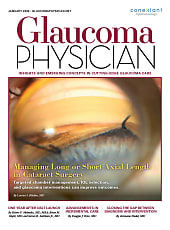With the introduction of more advanced technology intraocular lenses (ATIOLs) and their continued advancements, patients, surgeons, and staff members have more options to consider for lens replacement than ever before. Recent research has shown that 96% of past patients followed their ophthalmologists’ intraocular lens (IOL) recommendations. However, only 33% of patients received a recommendation.1
These data reveal a significant gap occurring during the cataract surgery process. Much more dialogue among doctors, staff members, and patients is required to ensure that all patients receive the information they need to make informed IOL selections. My staff and I have discovered a unique opportunity to work together to devise a strategy that provides our patients with all their options, but it requires our team to be even more knowledgeable about patient communication skills and education to effectively offer IOL options.
Tools for Implementing Patient Education in Your Practice
My goal has always been that, no matter with whom at my practice a patient meets, they will receive trustworthy, confidently delivered information about the IOLs available to them. To accomplish this goal, I have spent decades honing my process, making preoperative and postoperative patient education a top priority for myself and my staff. Even though I am proud of the education we offer our patients, I would have welcomed the opportunity to have some help along the way, especially for my staff. The Alcon Accelerator program does just that.
Alcon Accelerator is a value-added program that practices can use to fill the current gap in patient education. This program provides surgeons and staff with comprehensive tools and resources focused on the patient journey and guiding patients to make knowledgeable decisions — so practices no longer need to “reinvent the wheel” when it comes to actualizing patient education in their day-to-day workflows. It also allows staff to play an even more meaningful role in the process by increasing their comfort level in talking to patients about ATIOLs.
My approach to patient education requires close partnership with my staff members. It begins with education that fosters understanding, allowing myself, the staff, and the patients to more effectively participate in the decision-making process, and it ends with a strong recommendation on 1 or 2 IOL options based on what we know the patient values.
Making Strong Recommendations
In my experience, when cataract patients have all the information they need before their evaluation by an eye doctor, they can play a far more proactive role in their decision to choose the right IOL that fits their individual lifestyle needs. The selection they make can be critical — the right IOL can have a truly transformative impact on their quality of life.2 Arriving at these recommendations is much easier with the help of my staff. Let’s look at a recent example.
A cataract patient told an ophthalmic tech in my practice how excited she was to receive Alcon’s Clareon Vivity IOL, because she had heard great things about it from her neighbor. After working up the patient and conducting diagnostics, the tech began to suspect that the Clareon Vivity might not be the ideal selection for this particular patient after all.
Before I stepped into the exam room, the tech pulled me aside and let me know about the patient’s preappointment exposure to, and preference for, the Vivity lens, as well as their suspicion that the patient may actually receive more postsurgery value from the Clareon PanOptix IOL.
After asking the patient 3 simple questions, we were able to confirm that, although she was exposed to ATIOL technology before the appointment, her understanding was indeed incomplete.
This patient rarely wore glasses, including for reading. However, the Clareon Vivity would almost certainly require her to wear reading glasses.3 Had she received Vivity, it may have caused a change in her lifestyle that could have led to reduced postsurgical satisfaction.
Rather than giving this patient the lens she initially asked for, my tech and I were able to work together to help this patient select the IOL that would better meet their expectations. We landed on suggesting the Clareon PanOptix, which offers greater independence from glasses.4,5
This is the “Educate” component of the Alcon Accelerator program, which seeks to improve the patient experience through effective education, even when patients come in with background knowledge.
Once you have determined that a patient is a candidate for an ATIOL and understand what they find valuable in their vision, the next step is making a strong recommendation based on what you have learned. This is the “Demonstrate” portion of the Alcon Accelerator, and it involves leveraging your value-based conversations with patients to highlight how an ATIOL, such as the Clareon PanOptix or Clareon Vivity, can help them to maintain or improve what they value most in their vision.3,4
Customizing a Communications Approach for Your Practice
After several conversations with my staff members, it became clear that, although they understood the intricacies of each lens option, it was often difficult for them to know how to describe some of these nuances to patients in an easily digestible way. The Alcon Accelerator program provides you and your staff with customizable tools and learning sessions to understand how to better communicate with patients.
Together with Alcon, surgeons will work to identify a lead staff member to seamlessly support the implementation of the Accelerator program. From there, a practice assessment, including a patient journey, clinical foundation, and business review, will be completed.
Based on the findings from the practice assessment, Alcon and the entire staff come together for lunch-and-learn sessions to discuss and determine a strategy for the role that each team member will play in communicating with patients and the process for delivering the best possible lens recommendations.
Just like IOLs, Alcon Accelerator is not a one-size-fits-all program. Alcon can effectively partner with your practice to implement resources that increase patient education and optimize Alcon ATIOL outcomes.
As a committed partner to practices and their patients, Alcon also has a comprehensive library of printed and digital ATIOL educational resources. There is no better time for you to begin exploring the options to expand your patient education efforts and receive better support from your staff.
References
1. 2021 Consumer Decision Making Research. Percent selecting top 3 box on 110 scale, n=297.
2. 2023 Global Alcon Cataract Survey.
3. Clareon Vivity Directions for Use.
4. Clareon PanOptix Directions for Use.
5. Zhu D, Ren S, Mills K, Hull J, Dhariwal M. Rate of complete spectacle independence with a trifocal intraocular lens: a systematic literature review and meta-analysis. Ophthalmol Ther. 2023;12(2):1157-1171.
Disclosure: Dr. McCabe is a consultant for Alcon.









